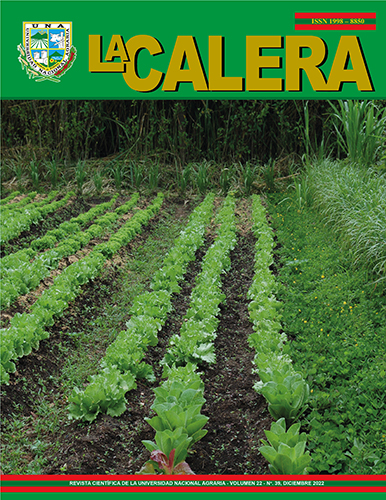Abundance, richness and diversity of insects associated to passion fruit (Passiflora edulis Sims) in Matagalpa, Nicaragua
DOI:
https://doi.org/10.5377/calera.v22i39.14807Keywords:
Index, dominance, fluctuation, populationAbstract
Passion fruit (Passiflora edulis, Sims) is a tropical fruit that belongs to the Passifloraceae family, in Nicaragua it is planted mainly in Matagalpa, this study was carried out in order to contribute to the scientific knowledge of insects associated with passion fruit, it was established between April and September 2016 in the Molino Sur Sébaco community, Matagalpa, the objective of the study was to identify, calculate the abundance, richness, diversity and feeding habit of the main families of insects associated with passion fruit. The study was carried out on four farms, using three pitfall traps and three gallon traps with molasses and the observational method. The main families of insects found were: Formicidae, Noctuidae, Pyralidae, Tachinidae, Ichneumonidae, Lonchaeidae, Pompilidae, Apidae, Tephritidae and Scarabaeidae. Insect abundance, richness and diversity were calculated, the latter was estimated using the Simpson index. It was found that the greatest abundance and dominance of insects associated with the cultivation of passion fruit was found in the El Conflicto farm, but not the most diverse in number of species. Regarding the richness of insects, ten orders, forty-eight families, sixty-nine genera and 23 identified species were found, among the main eating habits of the insect species associated with the cultivation of passion fruit were, phytophagous, saprophagous, nectarivorous, predatory, polynivore, defoliator and parasitoid.
Downloads
608
PDF (Español (España)) 202
EPUB (Español (España)) 115
Published
How to Cite
Issue
Section
License
Copyright (c) 2022 Universidad Nacional Agraria

This work is licensed under a Creative Commons Attribution-NonCommercial-ShareAlike 4.0 International License.

